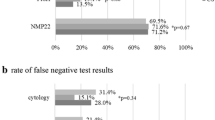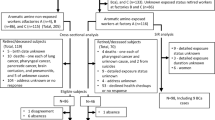Abstract
Purpose
To validate urinary markers for the early detection of bladder cancer (BC) in chemical workers.
Methods
UroScreen was conducted as a validation study for tumor markers within the frame of a health surveillance program of the German Social Accident Insurance for active or retired workers with former exposure to aromatic amines. From 2003 to 2010, 1,609 men took part in voluntary annual screens. Cytology, the quantitative NMP22® assay, and UroVysion™ were applied to 7,091 urine samples.
Results
Fifteen out of 21 tumors were detected following test positivity. The UroVysion/NMP22 panel detected 14 out of 21 tumors versus 8 tumors with cytology alone (sensitivity 66.7 vs. 44.4 %, specificity 94.5 vs. 98.5 %). The sensitivity of the panel increased to 85.7 % in samples collected ≤12 months before diagnosis and when papillomas were excluded, compared to 58.3 % with cytology. About 3 % of NMP22 tests were false-positive. UroVysion results overlapped with cytology due to the preselection of atypical cells. NMP22 was less and UroVysion more frequently positive in diluted urine samples. Leukocytes confounded NMP22 but not UroVysion. The low incidence of BC in this study population yielded low positive predictive values of the markers and high costs per tumor detected with screening.
Conclusions
UroVysion in combination with NMP22 detected more cases than cytology alone, at the expense of a lower specificity. High costs per detected case resulted from a lower BC incidence than in the past when levels of occupational exposure to aromatic amines were higher. Currently, it cannot be recommended to apply these markers for screening in asymptomatic workers. The increase in sensitivity is not balanced by the high costs of UroVysion and the false-positive tests of NMP22.


Similar content being viewed by others
References
Abd El Gawad I, Moussa HS, Nasr MI, El Gemae EH, Masooud AM, Ibrahim IK, El Hifnawy NM (2005) Comparative study of NMP-22, telomerase, and BTA in the detection of bladder cancer. J Egypt Natl Canc Inst 17:193–202
Aberle DR, DeMello S, Berg CD, Black WC, Brewer B, Church TR, Clingan KL, Duan F, Fagerstrom RM, Gareen IF et al (2013) Results of the two incidence screenings in the national lung screening trial. N Engl J Med 369:920–931
Aravidis C, Panani AD, Kosmaidou Z, Thomakos N, Rodolakis A, Antsaklis A (2012) Detection of numerical abnormalities of chromosome 9 and p16/CDKN2A gene alterations in ovarian cancer with fish analysis. Anticancer Res 32:5309–5313
Babjuk M, Oosterlinck W, Sylvester R, Kaasinen E, Bohle A, Palou-Redorta J, Roupret M (2011) EAU guidelines on non-muscle-invasive urothelial carcinoma of the bladder, the 2011 update. Eur Urol 59:997–1008
Banek S, Schwentner C, Taeger D, Pesch B, Nasterlack M, Leng G, Gawrych K, Bonberg N, Johnen G, Kluckert M et al (2012) Prospective evaluation of fluorescence-in situ-hybridization to detect bladder cancer: results from the UroScreen-study. Urol Oncol. doi:10.1016/j.urolonc.2012.04.015
Behrens T, Bonberg N, Casjens S, Pesch B, Brüning T (2013) A practical guide to epidemiological practice and standards in the identification and validation of diagnostic markers using a bladder cancer example. BBA Proteins Proteomics. doi:10.1016/j.bbpap.2013. Article first published online: 18 July 2013
Bonberg N, Taeger D, Gawrych K, Johnen G, Banek S, Schwentner C, Sievert KD, Wellhausser H, Kluckert M, Leng G et al (2013) Chromosomal instability and bladder cancer—the UroVysion™ test in the UroScreen study. BJU Int. doi:10.1111/j.1464-410X.2012.11666.x
Brenner DE, Normolle DP (2007) Biomarkers for cancer risk, early detection, and prognosis: the validation conundrum. Cancer Epidemiol Biomarkers Prev 16:1918–1920
Chamie K, Saigal CS, Lai J, Hanley JM, Setodji CM, Konety BR, Litwin MS (2011) Compliance with guidelines for patients with bladder cancer: variation in the delivery of care. Cancer 117:5392–5401
FDA, U.S.Federal Food and Drug Administration (2000) NMP22. http://www.accessdata.fda.gov/scripts/cdrh/cfdocs/cfTopic/pma/pma.cfm?num=P940035S002. Accessed 29 May 2013
FDA, U.S.Federal Food and Drug Administration (2005) UroVysion. http://www.accessdata.fda.gov/scripts/cdrh/cfdocs/cfTopic/pma/pma.cfm?num=P030052. Accessed 29 May 2013
Fischer CG, Waechter W, Kraus S, Fuentecilla PE, Weidner W, Dudeck J (1998) Urologic tumors in the Federal Republic of Germany: data on 56,013 cases from hospital cancer registries. Cancer 82:775–783
Freudenthal RI, Stephens E, Anderson DP (1999) Determining the potential of aromatic amines to induce cancer of the urinary bladder. Int J Toxicol 18:353–359
Grossman HB, Messing E, Soloway M, Tomera K, Katz G, Berger Y, Shen Y (2005) Detection of bladder cancer using a point-of-care proteomic assay. JAMA 293:810–816
Hemstreet GP III, Yin S, Ma Z, Bonner RB, Bi W, Rao JY, Zang M, Zheng Q, Bane B, Asal N et al (2001) Biomarker risk assessment and bladder cancer detection in a cohort exposed to benzidine. J Natl Cancer Inst 93:427–436
Huber S, Schwentner C, Taeger D, Pesch B, Nasterlack M, Leng G, Mayer T, Gawrych K, Bonberg N, Pelster M et al (2012) Nuclear matrix protein-22: a prospective evaluation in a population at risk for bladder cancer. Results from the UroScreen study. BJU Int 110:699–708
Jemal A, Bray F, Center MM, Ferlay J, Ward E, Forman D (2011) Global cancer statistics. CA Cancer J Clin 61:69–90
Johnen G, Gawrych K, Bontrup H, Pesch B, Taeger D, Banek S, Kluckert M, Wellhausser H, Eberle F, Nasterlack M et al (2012) Performance of survivin mRNA as a biomarker for bladder cancer in the prospective study UroScreen. PLoS One 7:e35363
Klorin G, Rozenblum E, Glebov O, Walker RL, Park Y, Meltzer PS, Kirsch IR, Kaye FJ, Roschke AV (2013) Integrated high-resolution array CGH and SKY analysis of homozygous deletions and other genomic alterations present in malignant mesothelioma cell lines. Cancer Genet 206:191–205
Kumara-Siri MH, Shapiro LE, Surks MI (1986) Association of the 3,5,3'-triiodo-L-thyronine nuclear receptor with the nuclear matrix of cultured growth hormone-producing rat pituitary tumor cells (GC cells). J Biol Chem 261:2844–2852
Larre S, Catto JW, Cookson MS, Messing EM, Shariat SF, Soloway MS, Svatek RS, Lotan Y, Zlotta AR, Grossman HB (2013) Screening for bladder cancer: rationale, limitations, whom to target, and perspectives. Eur Urol 63:1049–1058
Lokeshwar VB, Schroeder GL, Selzer MG, Hautmann SH, Posey JT, Duncan RC, Watson R, Rose L, Markowitz S, Soloway MS (2002) Bladder tumor markers for monitoring recurrence and screening comparison of hyaluronic acid-hyaluronidase and BTA-Stat tests. Cancer 95:61–72
Lokeshwar VB, Habuchi T, Grossman HB, Murphy WM, Hautmann SH, Hemstreet GP III, Bono AV, Getzenberg RH, Goebell P, Schmitz-Drager BJ et al (2005) Bladder tumor markers beyond cytology: international consensus panel on bladder tumor markers. Urology 66:35–63
Lotan Y, Shariat SF (2008) Impact of risk factors on the performance of the nuclear matrix protein 22 point-of-care test for bladder cancer detection. BJU Int 101:1362–1367
Lotan Y, Svatek RS, Sagalowsky AI (2006) Should we screen for bladder cancer in a high-risk population? A cost per life-year saved analysis. Cancer 107:982–990
Lotan Y, Capitanio U, Shariat SF, Hutterer GC, Karakiewicz PI (2009a) Impact of clinical factors, including a point-of-care nuclear matrix protein-22 assay and cytology, on bladder cancer detection. BJU Int 103:1368–1374
Lotan Y, Elias K, Svatek RS, Bagrodia A, Nuss G, Moran B, Sagalowsky AI (2009b) Bladder cancer screening in a high risk asymptomatic population using a point of care urine based protein tumor marker. J Urol 182:52–57
Nasterlack M, Scheuermann B, Messerer P, Pallapies D, Zober A (2001) Harnblasenkrebs in einem Risikokollektiv: Klinische und epidemiologische Aspekte. Symp Med 12:17–19
Panani AD, Maliaga K, Babanaraki A, Bellenis I (2009) Numerical abnormalities of chromosome 9 and p16CDKN2A gene deletion detected by FISH in non-small cell lung cancer. Anticancer Res 29:4483–4487
Pepe MS, Feng Z, Janes H, Bossuyt PM, Potter JD (2008) Pivotal evaluation of the accuracy of a biomarker used for classification or prediction: standards for study design. J Natl Cancer Inst 100:1432–1438
Pesch B, Nasterlack M, Eberle F, Bonberg N, Taeger D, Leng G, Feil G, Johnen G, Ickstadt K, Kluckert M et al (2011) The role of haematuria in bladder cancer screening among men with former occupational exposure to aromatic amines. BJU Int 108:546–552
Ransohoff DF (2013) Cultivating cohort studies for observational translational research. Cancer Epidemiol Biomarkers Prev 22:481–484
Rehn L (1895) Blasengeschwülste bei Fuchsin-Arbeitern. Archiv für Klinische Chirurgie 50:588–600
Sauter G, Algaba F, Amin M, Busch C, Cheville J, Gasser T, Grignon D, Hofstaedter F, Lopez-Beltran A, Epstein J (2004) Noninvasive urothelial neoplasias: WHO classification of noninvasive papillary urothelial tumors. In: Eble JN, Sauter G, Epstein JI, Sesterhenn IA (eds) World Health Organization classification of tumors. Pathology and genetics of tumors of the urinary system and male genital organs, 3rd edn. IARC Press, Lyon
Shariat SF, Karam JA, Lotan Y, Karakiewizc PI (2008) Critical evaluation of urinary markers for bladder cancer detection and monitoring. Rev Urol 10:120–135
Sharma S, Zippe CD, Pandrangi L, Nelson D, Agarwal A (1999) Exclusion criteria enhance the specificity and positive predictive value of NMP22 and BTA stat. J Urol 162:53–57
Sullivan P, Chan J, Levin M, Rao J (2010) Urine cytology and adjunct markers for detection and surveillance of bladder cancer. Am J Transl Res 2:412–440
Todenhoefer T, Hennenlotter J, Witstruk M, Gakis G, Aufderklamm S, Kuehs U, Stenzl A, Schwentner C (2012) Influence of renal excretory function on the performance of urine based markers to detect bladder cancer. J Urol 187:68–73
van Rhijn BW, van der Poel HG, Van der Kwast TH (2005) Urine markers for bladder cancer surveillance: a systematic review. Eur Urol 47:736–748
Vineis P, Pirastu R (1997) Aromatic amines and cancer. Cancer Causes Control 8:346–355
Zhu CS, Pinsky PF, Cramer DW, Ransohoff DF, Hartge P, Pfeiffer RM, Urban N, Mor G, Bast RC Jr, Moore LE et al (2011) A framework for evaluating biomarkers for early detection: validation of biomarker panels for ovarian cancer. Cancer Prev Res (Phila) 4:375–383
Acknowledgments
We thank Friedhelm Eberle for the careful execution and documentation of the urinalyses. This unique database allowed the exploration of the influence of the urine status on the tumor tests.
Conflict of interest
The study received a Grant (FB093) from the German Social Accident Insurance (DGUV), Sankt Augustin, Germany. A.S. received free assay kits from Abbott Laboratories and Matritech/Alere Ltd. G.J. received free assay reagents from Fujirebio Diagnostics, Inc. M.K. and H.W. are employees of the sponsor. Y.L. does research with Abbott Laboratories and Matritech/Alere Ltd.
Author information
Authors and Affiliations
Consortia
Corresponding author
Additional information
Beate Pesch and Dirk Taeger have equally contributed to this article.
Please refer the “Appendix” section for UroScreen Study Group.
Appendix
Appendix
UroScreen Study Group
BASF SE, Department of Occupational Medicine and Health Protection, Ludwigshafen: Bernd Scheuermann, Friedhelm Eberle, Thomas Mayer, Michael Nasterlack.
BG RCI, Bereich Prävention, Heidelberg: Harald Wellhäußer, Matthias Kluckert; Organisationsdienst für nachgehende Untersuchungen (ODIN): Reinhard Detzner.
Institute for Prevention and Occupational Medicine of the German Social Accident Insurance, Institute of Ruhr-Universität Bochum (IPA), Bochum: Dirk Taeger, Beate Pesch, Katarzyna Gawrych, Heike Bontrup, Georg Johnen, Nadine Bonberg, Judith Delbanco, Evelyn Heinze, Thomas Brüning.
Protein Research Unit Ruhr within Europe (PURE), Ruhr University of Bochum: Nadine Bonberg.
Currenta GmbH & Co. OHG, Safety—Health Protection, Leverkusen: Gabriele Leng.
Institute of Urology, Eberhard Karls University, Tübingen: Gerhard Feil, Karl-Dietrich Sievert, Séverine Banek, Christian Schwentner, Margarete Geiger, Erika Senger, Valentina Gerber, Andrea Hohneder, Gundi Beger, Ursula Kuehs, Jörg Hennenlotter, Arnulf Stenzl.
Rights and permissions
About this article
Cite this article
Pesch, B., Taeger, D., Johnen, G. et al. Screening for bladder cancer with urinary tumor markers in chemical workers with exposure to aromatic amines. Int Arch Occup Environ Health 87, 715–724 (2014). https://doi.org/10.1007/s00420-013-0916-3
Received:
Accepted:
Published:
Issue Date:
DOI: https://doi.org/10.1007/s00420-013-0916-3




